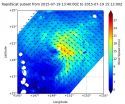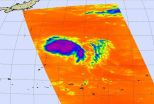Satellite data shows Tropical Cyclone Halola getting stronger
2015-07-20
(Press-News.org) Tropical Depression Halola is getting stronger. NASA data pinpointed the area of strongest sustained winds on July 19 and the extent of those winds expanded on July 20 as Halola became a tropical storm again. NASA also gathered infrared data that showed cloud top temperatures getting colder, indicating more uplift or strength in the storm.
On July 19 at 2 p.m. GMT (10 a.m. EDT), the RapidScat instrument aboard the International Space Station gathered data on surface winds in Tropical Depression Halola. RapidScat saw the strongest sustained winds were on the northeastern side as strong as 22 meters per second (49.2 mph/79.2 kph). Winds around the rest of the storm were less strong.
The area of strongest winds appeared to expand on July 20 at 1152 UTC (7:52 a.m. EDT) when the ASCAT-A (Advanced Scatterometer) instrument that flies aboard Europe's EUMETSAT METOP satellite gathered wind data. ASCAT-A showed that Halola's winds were still not symmetrical, but the strongest winds were now along the northern and southeastern edges of the storm.
ASCAT uses radar to measure the electromagnetic backscatter from the wind-roughened ocean surface, from which data on wind speed and direction can be derived. These products are processed by NOAA/NESDIS utilizing measurements from ASCAT.
The Atmospheric Infrared Sounder (AIRS) instrument that flies aboard NASA's Aqua satellite captured infrared data on Halola. AIRS data showed cloud top temperatures were again as cold as -63F/-53C north and east of Tropical Storm Halola's center on July 20 at 3:05 UTC, indicating that there was stronger uplift of air in the storm which can push thunderstorm cloud tops higher in the atmosphere.
NASA research has determined that cloud tops with temperatures near -63 Fahrenheit or -53 Celsius have the ability to generate heavy rainfall (that's over 1 inch or 25 millimeters per hour). When cloud top temperatures are colder than that, the thunderstorms are likely to reach higher in the atmosphere and are likely to be stronger.
Tropical Depression Halola has once again become a tropical storm. At 1500 UTC (11 a.m. EDT), Halola's maximum sustained winds had increased to 50 knots (57.5 mph/92.6 kph). It was centered near 22.0 North latitude and 145.8 East longitude, about 334 nautical miles (384.4 miles/ 618.6 kph) east-southeast of Iwo To island, Japan. Halola has tracked west-northwestward at 12 knots (13.8 mph/22.2 kph).
The Joint Typhoon Warning Center noted that "animated enhanced infrared satellite imagery depicts tight curved banding [of thunderstorms] wrapping around the northern [quadrant] of the cyclone into a well-consolidated low level circulation center." Microwave data from the METOP-B satellite image showed that an eye was developing.
The Joint Typhoon Warning Center (JTWC) noted that vertical wind shear is easing, and Halola is forecast to move through warm sea surface temperatures allowing for it to strengthen. JTWC calls for Halola to reach typhoon status on Tuesday, July 21 and continue strengthening to 80 knots (92.0 mph/148.2 kph) before weakening on July 24.
INFORMATION:
For more information about how NASA uses infrared light in tropical cyclone research, visit:
http://www.nasa.gov/feature/goddard/a-lesson-in-infrared-light-looking-at-three-tropical-cyclones
[Attachments] See images for this press release:


ELSE PRESS RELEASES FROM THIS DATE:
2015-07-20
Antiretroviral treatment that consistently suppresses HIV is highly effective at preventing sexual transmission of the virus in heterosexual couples where one person is HIV-infected and the other is not, investigators report today at the 8th International AIDS Society Conference on HIV Pathogenesis, Treatment & Prevention (IAS 2015) in Vancouver, Canada. The finding comes from the decade-long HPTN 052 clinical trial funded primarily by the National Institute of Allergy and Infectious Diseases (NIAID), part of the National Institutes of Health, and conducted by the NIH-funded ...
2015-07-20
Researchers from the University of Copenhagen have discovered a way of improving biotech drugs. Better, cheaper and more effective drugs to combat cancer, arthritis and many other disorders.
This is the result of a ground-breaking new technique developed by a group of researchers from the Faculty of Health and Medical Sciences at the University of Copenhagen.
The method can improve a large number of so-called glycoprotein-based pharmaceuticals used to treat a variety of diseases. The technique has recently been described in one of the world's most distinguished scientific ...
2015-07-20
No one likes to lose a friend, especially adolescents. But why do friendships end? Researchers in the Charles E. Schmidt College of Science at Florida Atlantic University sought to answer this question with a study examining whether adolescent friendships end because of undesirable characteristics of friends, because of differences between friends, or both. Findings from this long-term longitudinal study of 410 adolescents involved in 573 friendships are published in the current issue of Psychological Science.
Adolescent friendships are fleeting. The majority dissolve ...
2015-07-20
WASHINGTON, July 20, 2015 -- If you're stumped in the wine aisle of the store, then you're not alone. Every bottle has unique nuances of taste and smell. How can something made of grapes smell buttery or taste like grass? Learn about the complex chemistry behind wine and then impress your friends at your next party thanks to Reactions. Check out our wine chemistry primer here: http://youtu.be/_UaS743_aEs.
Subscribe to the series at http://bit.ly/ACSReactions, and follow us on Twitter @ACSreactions to be the first to see our latest videos.
INFORMATION:
The American ...
2015-07-20
Nearly a third of breast cancer survivors in Appalachia are not taking the critical, potentially life-saving follow-up treatment - despite having insurance that would pay for it, a troubling new study has found.
Researchers cross-examined cancer registries with Medicare claims data and determined that of 428 women, approximately 30 percent failed to follow through with their prescribed adjuvant hormone therapy, a treatment to prevent the cancer's recurrence.
"Almost a third of the prescriptions for adjuvant hormone therapy were not filled, which is much, much higher ...
2015-07-20
ATLANTA--States' regulations of health insurance and practitioners significantly influence when patients receive colorectal or breast cancer diagnoses, especially among people younger than the Medicare-eligible age of 65, according to a new study by researchers at Georgia State University's School of Public Health and the University of North Carolina at Chapel Hill.
The study suggests that where people live is a strong predictor of whether they will receive potentially life-saving cancer screenings.
Dr. Lee Rivers Mobley, associate professor of spatial science and health ...
2015-07-20
Oceans have absorbed up to 30 percent of human-made carbon dioxide around the world, storing dissolved carbon for hundreds of years. As the uptake of carbon dioxide has increased in the last century, so has the acidity of oceans worldwide. Since pre-industrial times, the pH of the oceans has dropped from an average of 8.2 to 8.1 today. Projections of climate change estimate that by the year 2100, this number will drop further, to around 7.8 -- significantly lower than any levels seen in open ocean marine communities today.
Now a team of researchers from MIT, the University ...
2015-07-20
Marine species that already roam far and wide throughout our oceans are extending their territories further and faster in response to climate change, according to new research involving the University of Southampton and an international team of biodiversity experts.
The study found that while species that have large ranges are able to make their way to cooler waters, small-ranging species are in increased jeopardy as our planet's oceans continue to warm.
"Our findings indicate that animals which already have wide-latitudinal ranges, habitat generalists, and species with ...
2015-07-20
New Haven, Conn. -- Researchers at Yale School of Medicine have successfully treated patients with moderate to severe eczema using a rheumatoid arthritis drug recently shown to reverse two other disfiguring skin conditions, vitiligo and alopecia areata. The study is evidence of a potential new era in eczema treatment, they report.
The research findings are published early online in the Journal of the American Academy of Dermatology.
Eczema (atopic dermatitis) is a chronic condition that causes severe itching and leaves the skin red and thickened. It can adversely affect ...
2015-07-20
A slow-down in global warming is not a sign that climate change is ending, but a natural blip in an otherwise long-term upwards trend, research shows.
In a detailed study of more than 200 years' worth of temperature data, results backed previous findings that short-term pauses in climate change are simply the result of natural variation.
The findings support the likelihood that a current hiatus in the world's year-on-year temperature increases - which have stalled since 1998 - is temporary.
Scientists from the University of Edinburgh analysed real-world historic ...
LAST 30 PRESS RELEASES:
[Press-News.org] Satellite data shows Tropical Cyclone Halola getting stronger



